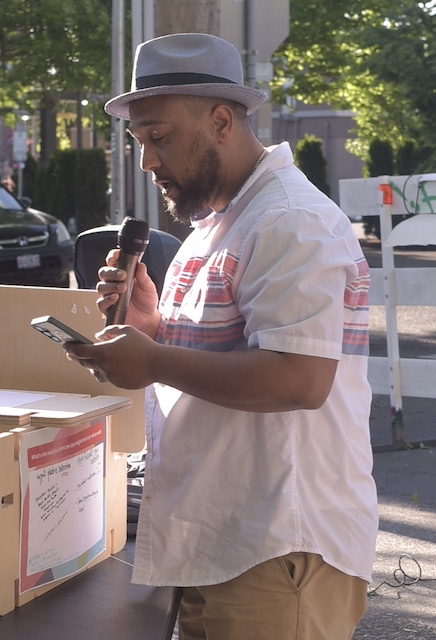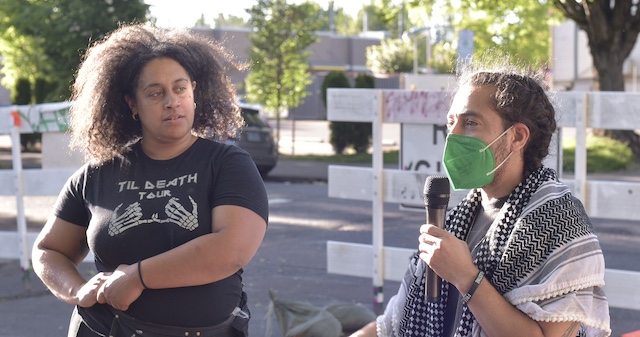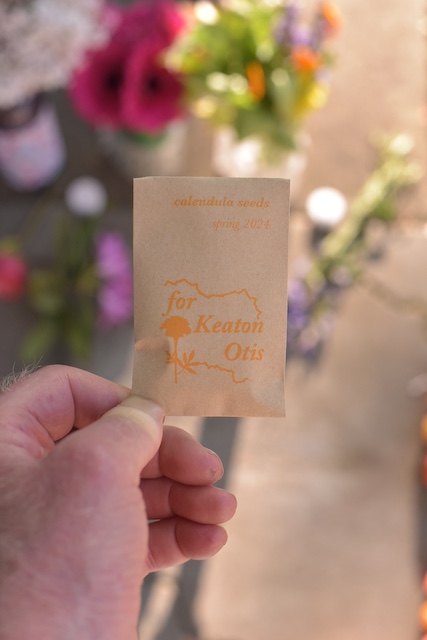
Story and photos by Pete Shaw
Hope is the seed that gives rise to justice.
On May 12, a sizable crowd of 35 people showed up at the corner of NE 6th and Halsey, where people have been gathering for nearly 14 years now, month by month, to mark the anniversary of Keaton Otis’s murder by Portland police. In 2010, the 25 year old Otis was pulled over because an officer of Portland’s Gang Enforcement Team determined that Otis “was wearing a hoodie…He kind of looks like he could be a gangster.” Otis was pulled over for driving while Black. Other police joined and surrounded Otis, who had been driving his mother’s car. A few minutes later, after six police officers unloaded 23 bullets into the car, Keaton Otis was dead. The police would later say Otis fired at them first. Only one of the six officers said Otis had a gun, but he later admitted he never saw one. No gun has ever been produced, and justice for Keaton Otis, as with so many people murdered by police, remains elusive.
On the 12th of each month, starting in June 2010, through heat and frigid temperatures, through times of good health and times of Covid, people have assembled at this corner, remembering what was and what might have been, as well as looking toward what may and what must be. Fred Bryant, the father of Keaton Otis, began the vigils one month after his son’s murder. He sought justice for his son, a terrible burden no parent should have to bear. Not long after beginning the vigils, the weight proved too heavy. Fred Bryant passed in October 2013 at the age of 53.
Over the years, with the support of groups including Pacific Northwest Family Circle, Asians for Black Lives, Black Lives Matter Portland, SURJ PDX, and Portland Copwatch , the vigils have expanded to include the victims of all police violence, a list that shows no sign of letting up. According to the website Mapping Police Violence, as of May 10, police in the United States have killed at least 433 people in 2024. There have only been nine days this year when police did not kill somebody. In 2023, police killed at least 1,247 people, the highest number of police killings in over a decade. 27% of them were Black people, despite Black people making up only 13% of the US population. Mapping Police Violence predicts that 2024 will see a similar number of people murdered by police.

Behind each of these numbers is a name, a life with a story composed of the myriad of qualities and complexities that are germane to all of us. Those lives and their stories do not end with death. They carry on among those who survive and endure, and all who continue demanding justice.
This year’s memorial vigil was commemorated on Mother’s Day. I had not expected much of a crowd, and yet here were 35 people holding this space, this sacred space, on what for too many mothers must be one of the most painful days of the year, every year.. After all this time, community members continue showing up to provide support for mothers, fathers, brothers, sisters, other relatives, and Friends who bear the unbearable.
Walidah Imarisha of Justice for Keaton Otis emceed the event. She opened the memorial by noting, “Keaton was a father. He was a son. He was a friend. He was an artist. He was an entrepreneur. He was someone who built community and loved learning. He was by all rights an incredible human being who definitely made the world better being in it. And keeping his memory alive also makes the world better, not allowing Keaton to be forgotten.”
Helping keep Keaton Otis’s memory alive was one of his best Friends, Hip Hop artist and fashion designer Fabian John. One way John honors Otis by channeling Otis’s entrepreneurial spirit in the clothing he creates. Keaton Otis too was interested in fashion design and sparked John’s passion for it. His line of wear carries the spirit of Otis, and is branded under the name Keaton Otis created: Kommerce. His designs “are and will be inspired by the conversations” John had with Keaton, and “the visions he had for the brand.” John then displayed some of his–their–creations. To further help keep Otis’s legacy alive, John will contribute a portion of revenue to “nonprofits that help youths embrace their creative talents, sharpen their entrepreneurial skills, and have resources for mental health needs.”
The last time I had been down here, at least for an event, Sharita Towne and a clutch of people with helping hands were putting the finishing touches on the first stage of a more permanent memorial to Otis, Bryant, and all victims of police violence. The results were beautiful, and the love and thirst for justice behind them, more so. This phase of the memorial was modeled on kintsugi, the Japanese art of repairing broken pottery in which shards are brought back together with a lacquer mixed with powdered gold, silver, or platinum. The pottery is not just repaired, but actually strengthened. Its cracks are not hidden. Left in plain sight as part of the pottery’s history, the evident fissures invite the viewer to consider the former unbroken piece, its fragments, and the piece now in repair, an entirety of a now greater whole both in spite and because of what it has endured. Towne’s vision–and I should note here that she felt uncomfortable being referred to as “the artist”–and the work of those who manifested it, resulted among other things in NE 6th having much of the tar used to fill the cracks in the street painted gold. It was a stirring sight.

If some of that paint has faded since then, the spirit of the work, which Towne told me two years ago was to remind people of “the need to accept the broken parts of people we know and love” so that we may “embrace and offer repair” to them, remains as bright as it was when the paint was being applied on that beautiful September morning in 2022.
On Sunday, Towne introduced C-Mo Montalbin, who teaches an “Intro to Shop” class to about 80 9th graders at Benson Polytechnic High School, outlined the next phase of the memorial. Montalbin talked about how for the past few years at Benson, which Keaton Otis attended, students have erected an altar in memory of Otis for the week of May 12. This year, for Benson’s Tech Show, an open house which is attended by many alumni and community members, the altar Montalbin’s students made featured the Benson yearbook for Otis’s graduating class. He said some of Otis’s classmates–some of them parents of Montalbin’s students–remembered Otis, a poignant connection of generations.
“Sharita and I,” Montalbin said, “have been working for some way to have this corner keep Keaton’s memory alive in a more permanent way in addition to the monthly vigils that we hold.”
Montalbin told the crowd how his students, along with him and Towne, are building a “platform, bench, planter boxes, and two little libraries that will live right here,” a reminder of what happened on this corner almost exactly 14 years to the moment Montalbin was speaking.

“Hopefully by the end of the Summer,” Montalbin said, “this will be a really nice place to gather. It will be built by students who have been talking about Keaton all year. We’ve been talking about who he is and really just remembering that he should be alive today.” Pointing to a bank of photos of these students working on the project, on a wall of the apartment complex which is pockmarked by some of the slugs that the police fired, Montalbin noted, “He was just like them, a high school student at some point in time.”
Attendees were invited to take a small packet of calendula seeds, and to sow them. Two Septembers ago, near one of the many vases of calendulas that were being placed for an official opening ceremony for the first phase of the memorial, Towne told me how many cultures use calendulas for both celebration and grieving. This particular variety, she said, was a type whose name recalled the passage of time.
Time, it is said, heals all wounds. I have long been skeptical of that would-be aphorism, and I know I am not alone in my unease. But these seeds, along with the community that will scatter them, will perhaps bear flowers that will one day provide some relief for those who have gathered here on the 12th of every month since Fred Bryant began his vigil for his son in June 2010, seeking justice. The memorial being erected welcomes a new generation of people thirsting for it too. Hoping for the justice that flowers when people and communities, against all odds, all belief, all sadness, all despair, and all emptiness, push on past the persistent hopelessness that haunts, grinds them, and tells them to stop. And sometimes, seemingly out of nowhere, justice blooms.
It always begins now.
“We’re taking this space,” said Imarisha as she brought the vigil to a close, “making sure Portland doesn’t forget Keaton, doesn’t forget Fred, doesn’t forget how important they were, and doesn’t forget that we are going to continue to fight for them, and justice for all who have been killed by police.”
The vigil demanding justice for Keaton Otis, Fred Bryant, and all victims of police violence is held on the 12th of every month, from 6-7 PM, at the corner of NE 6th and Halsey.






